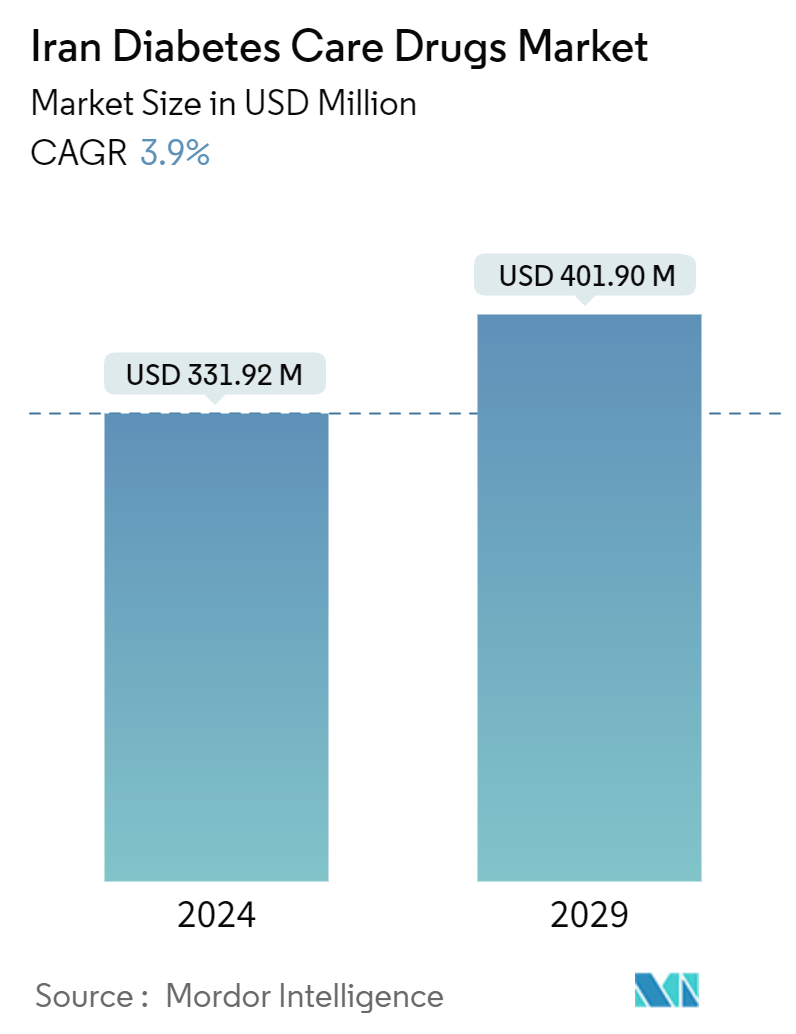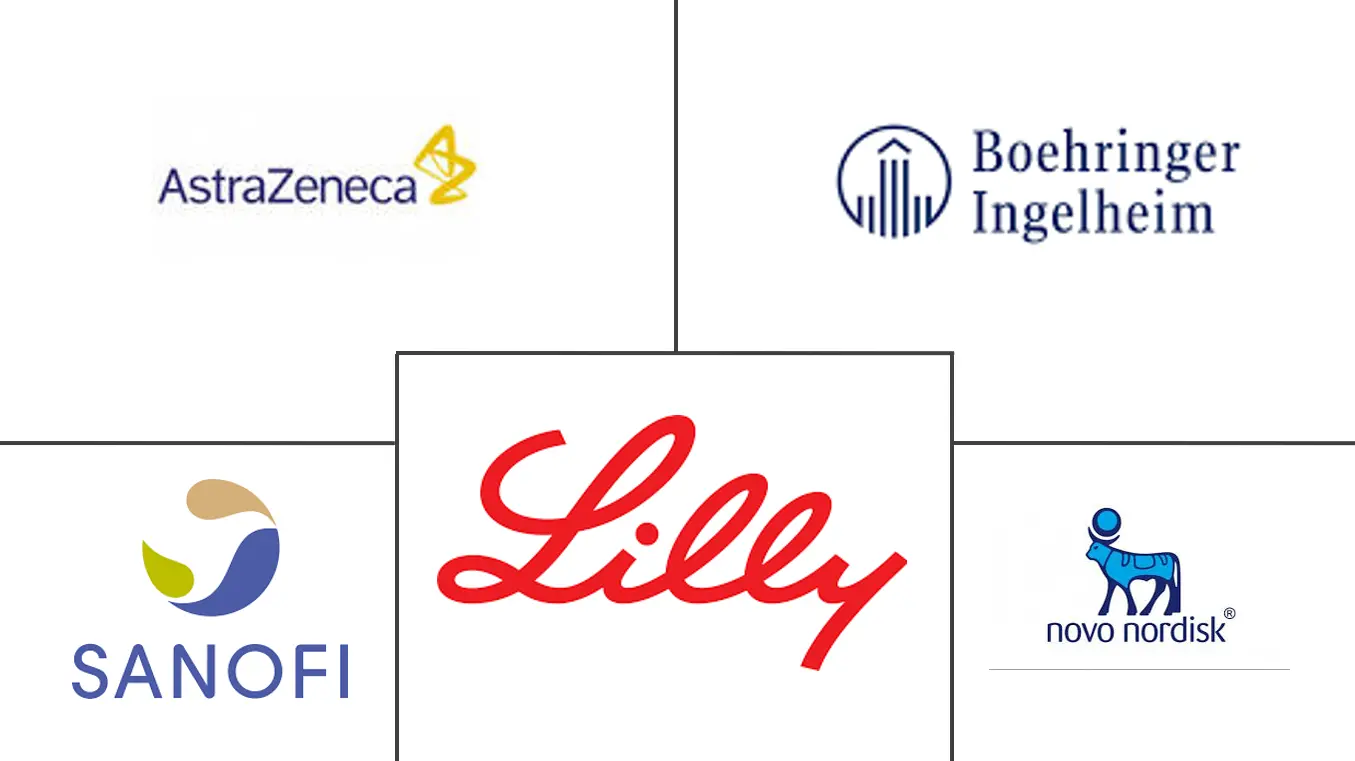Market Size of Iran Diabetes Care Drugs Industry

| Study Period | 2019 - 2029 |
| Base Year For Estimation | 2023 |
| Forecast Data Period | 2024 - 2029 |
| Market Size (2024) | USD 331.92 Million |
| Market Size (2029) | USD 401.90 Million |
| CAGR (2024 - 2029) | 3.90 % |
Major Players
*Disclaimer: Major Players sorted in no particular order |
Iran Diabetes Care Drugs Market Analysis
The Iran Diabetes Care Drugs Market size is estimated at USD 331.92 million in 2024, and is expected to reach USD 401.90 million by 2029, growing at a CAGR of 3.9% during the forecast period (2024-2029).
According to the World Health Organization's 2022 report, the prevalence of diabetes in Iran stands at 10.3%, with rates of 9.6% for men and 11.1% for women. In Yazd province, the prevalence of diabetes is notably higher at 16.3%. This disease is a result of a combination of genetic and environmental factors.
The rapid and significant lifestyle changes observed in many countries have led to an increase in obesity and other risk factors for non-communicable diseases. Common risk factors for diabetes include being overweight, obesity, low physical activity, high fat consumption, low fiber diet, race, family history, age, low birth weight, smoking, and high blood pressure.
Diabetes mellitus poses a significant healthcare challenge in Yazd province due to its prevalence, costs, and impact on individuals' lives, although it can be managed and prevented. Lifestyle-related factors play a crucial role in the early development of type 2 diabetes. Identifying these risk factors, understanding their individual contributions, and implementing interventions based on them are essential steps in diabetes management and prevention of complications.
Overall, the rise in the use of diabetes medications in iran is a positive development that reflects the growing awareness and understanding of diabetes as a chronic disease that requires ongoing management and treatment. With continued advancements in diabetes drug treatments and increased access to healthcare services, the diabetic population in iran can look forward to better outcomes and improved quality of life in the years to come.
Iran Diabetes Care Drugs Industry Segmentation
Diabetes or diabetes mellitus describes a group of metabolic disorders characterized by a high blood sugar level in a person. With diabetes, the body either does not produce enough insulin or the body's cells do not respond properly to insulin, or both. Iran Diabetes care drugs segment the market into Insulin, Oral Anti-Diabetic Drugs, Non-Insulin Injectable Drugs, and Combination Drugs. The report offers the value (in USD) and Volume (in unit) for the above segments.
| Oral Anti-diabetic drugs | ||||||
| ||||||
| ||||||
| ||||||
| ||||||
| ||||||
| ||||||
|
| Insulins | |||||||
| |||||||
| |||||||
| |||||||
|
| Combination drugs | |||||
| |||||
|
| Non-Insulin Injectable drugs | |||||||
| |||||||
|
Iran Diabetes Care Drugs Market Size Summary
The Iran Diabetes Care Drugs Market is poised for growth, driven by an increasing awareness of diabetes as a chronic condition requiring ongoing management. The market is characterized by a semi-consolidated structure, with major players like Novo-Nordisk, Sanofi, AstraZeneca, and Bristol Myers Squibb dominating the insulin and SGLT-2 drug segments. The oral diabetes drug market, including Sulfonylureas and Meglitinides, features a higher number of generic players, contributing to intense competition. This competitive landscape is further fueled by efforts to develop new drugs and expand into emerging markets, where demand significantly outstrips supply. The Iranian government's initiatives have also played a crucial role in boosting drug usage, reflecting a broader commitment to addressing the diabetes epidemic.
The prevalence of diabetes in Iran, exacerbated by lifestyle changes and economic challenges, underscores the importance of effective diabetes care and treatment. Despite the high costs of insulin and other diabetes-related supplies, which can consume a substantial portion of a family's income, the market is expected to grow as advancements in drug treatments and healthcare access continue. The National Program for Prevention and Control of Diabetes (NPPCD) has made strides in diabetes prevention and long-term care, although challenges remain in understanding the full scope of diabetes-related comorbidities and care quality. As the market evolves, the focus on improving drug adherence and optimizing treatment regimens will be critical in managing the growing diabetes burden in Iran.
Iran Diabetes Care Drugs Market Size - Table of Contents
-
1. MARKET DYNAMICS
-
1.1 Market Overview
-
1.2 Market Drivers
-
1.3 Market Restraints
-
1.4 Porter's Five Forces Analysis
-
1.4.1 Bargaining Power of Suppliers
-
1.4.2 Bargaining Power of Consumers
-
1.4.3 Threat of New Entrants
-
1.4.4 Threat of Substitute Products and Services
-
1.4.5 Intensity of Competitive Rivalry
-
-
-
2. MARKET SEGMENTATION
-
2.1 Oral Anti-diabetic drugs
-
2.1.1 Biguanides
-
2.1.1.1 Metformin
-
-
2.1.2 Alpha-Glucosidase Inhibitors
-
2.1.2.1 Alpha-Glucosidase Inhibitors
-
-
2.1.3 Dopamine D2 receptor agonist
-
2.1.3.1 Bromocriptin
-
-
2.1.4 SGLT-2 inhibitors
-
2.1.4.1 Invokana (Canagliflozin)
-
2.1.4.2 Jardiance (Empagliflozin)
-
2.1.4.3 Farxiga/Forxiga (Dapagliflozin)
-
2.1.4.4 Suglat (Ipragliflozin)
-
-
2.1.5 DPP-4 inhibitors
-
2.1.5.1 Onglyza (Saxagliptin)
-
2.1.5.2 Tradjenta (Linagliptin)
-
2.1.5.3 Vipidia/Nesina(Alogliptin)
-
2.1.5.4 Galvus (Vildagliptin)
-
-
2.1.6 Sulfonylureas
-
2.1.6.1 Sulfonylureas
-
-
2.1.7 Meglitinides
-
2.1.7.1 Meglitinides
-
-
-
2.2 Insulins
-
2.2.1 Basal or Long Acting Insulins
-
2.2.1.1 Lantus (Insulin Glargine)
-
2.2.1.2 Levemir (Insulin Detemir)
-
2.2.1.3 Toujeo (Insulin Glargine)
-
2.2.1.4 Tresiba (Insulin Degludec)
-
2.2.1.5 Basaglar (Insulin Glargine)
-
-
2.2.2 Bolus or Fast Acting Insulins
-
2.2.2.1 NovoRapid/Novolog (Insulin Aspart)
-
2.2.2.2 Humalog (Insulin Lispro)
-
2.2.2.3 Apidra (Insulin Glulisine)
-
-
2.2.3 Traditional Human Insulins
-
2.2.3.1 Novolin/Actrapid/Insulatard
-
2.2.3.2 Humulin
-
2.2.3.3 Insuman
-
-
2.2.4 Biosimilar Insulins
-
2.2.4.1 Insulin Glargine Biosimilars
-
2.2.4.2 Human Insulin Biosimilars
-
-
-
2.3 Combination drugs
-
2.3.1 Insulin combinations
-
2.3.1.1 NovoMix (Biphasic Insulin Aspart)
-
2.3.1.2 Ryzodeg (Insulin Degludec and Insulin Aspart)
-
2.3.1.3 Xultophy (Insulin Degludec and Liraglutide)
-
-
2.3.2 Oral Combinations
-
2.3.2.1 Janumet (Sitagliptin and Metformin)
-
-
-
2.4 Non-Insulin Injectable drugs
-
2.4.1 GLP-1 receptor agonists
-
2.4.1.1 Victoza (Liraglutide)
-
2.4.1.2 Byetta (Exenatide)
-
2.4.1.3 Bydureon (Exenatide)
-
2.4.1.4 Trulicity (Dulaglutide)
-
2.4.1.5 Lyxumia (Lixisenatide)
-
-
2.4.2 Amylin Analogue
-
2.4.2.1 Symlin (Pramlintide)
-
-
-
Iran Diabetes Care Drugs Market Size FAQs
How big is the Iran Diabetes Care Drugs Market?
The Iran Diabetes Care Drugs Market size is expected to reach USD 331.92 million in 2024 and grow at a CAGR of 3.9% to reach USD 401.90 million by 2029.
What is the current Iran Diabetes Care Drugs Market size?
In 2024, the Iran Diabetes Care Drugs Market size is expected to reach USD 331.92 million.

